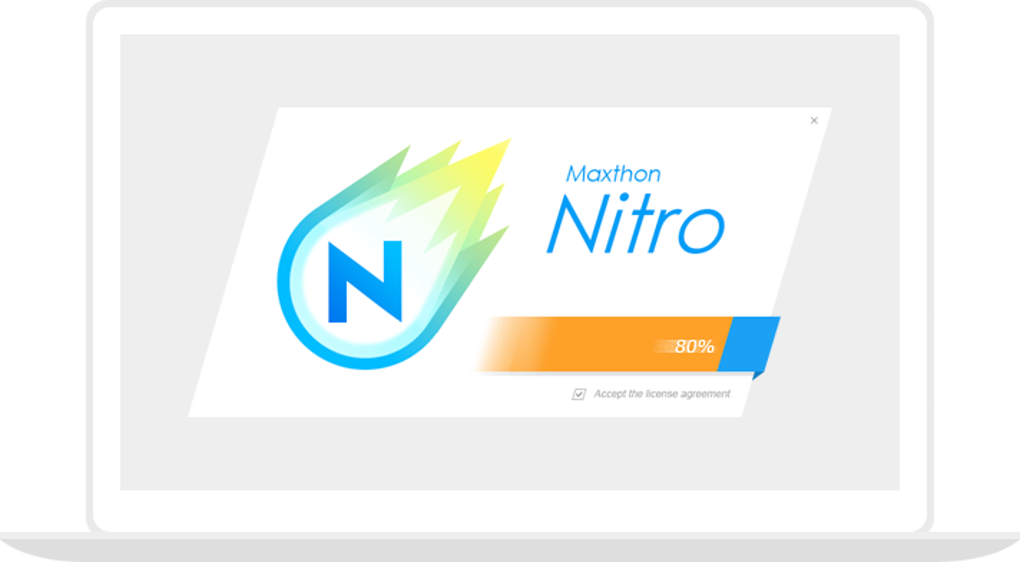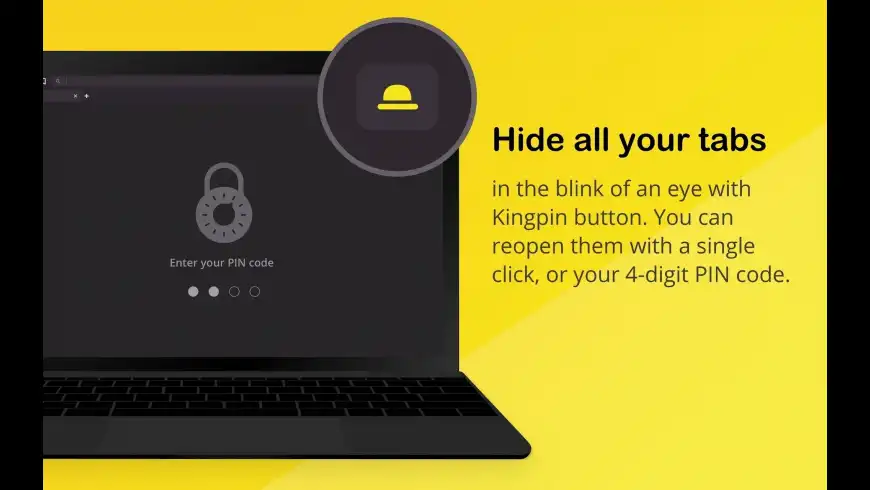You might have heard about private or incognito browsing. It’s the mode that doesn’t store anything in history. While it does store cookies, they are deleted after the session is exited.
This mode is known as Incognito browsing in Google Chrome, Private Browsing in Mozilla Firefox, and InPrivate Browsing in Internet Explorer. Whatever you may want to call it, the mode works the same in all browsers.
So when you enter the name of a website in the browser, the browser will check the DNS server and get the IP address of the site to open it. This entire process of communication between the browser and the DNS server gets recorded on your device – even if you’ve used private browsing.
The Kingpin Private Browser is a Mac privacy Browser. Adblock is built in and is always on. It does not record browsing history, passwords, or cookies. The browser defaults to The Google search engine (which can be changed to DuckDuckGo in Settings). Mainly used to securely browse online shopping sites and bank payment sites. Why you should try using the Kingpin browser: - Does not store. Kingpin Private Browser review and description. The Kingpin browser is a full-d browser with incognito mode and AdBlock always on. It does not remember browser history, passwords or cookies.
There are some browsers like Kingpin that work exclusively in Incognito mode so your history is never saved.
However, sometimes you might want to go back to a page that you previously opened. You saw a good recipe for the chicken casserole and thought you don’t have the time for this. Today your kids are coming over and you wish you had that recipe.
The question is – can you check your incognito history?
Problem is, there is no easy way to go back to that page. So the chicken casserole recipe you saw is effectively lost. Unless you can Google it up and it shows again. But if it’s not there on the first page of Google, it’s gone forever.
But if you’re a little tech-savvy, you can still get to know about the websites that have been browsed under the incognito mode.
Yep, the private browsing mode has a loophole. You can see the browsing history of someone using incognito mode but only if you have access to their computer. Also, they must be using the Windows operating system.
How to See Incognito History
Watch this video on YouTube
While incognito can protect you from most prying eyes, it won’t be able to protect you if someone went snooping into your DNS queries. Since these DNS queries are stored and can be accessed on a Windows device, you can find out a user’s browsing session’s details.
How DNS Works
A DNS server, or Domain Name System server, is a device that records the IP address and their hostnames. So when you enter the name of a website in the browser, the browser will check the DNS server and get the IP address of the site to open it.
This entire process of communication between the browser and the DNS server gets recorded on your device – even if you’ve used private browsing.
Now if you read the DNS results, it will show the browsing history of your computer. And it’s pretty simple to see the DNS results – you don’t have to be a bigshot hacker for this.
🔧 How to test this:
Open a website using incognito mode or Kingpin browser. Check the history and you’ll see it’s not present in the history list of the browser.
- Now click on the Windows icon given on the bottom left corner.
- Look for the command prompt. You can invoke it by typing cmd.
- Run the Command prompt as an administrator.
- You’ll see a black DOS window open up.
- Type ipconfig/displaydns>any locationfilename
- For example, let’s say you want to save the results in a text file called kingpin123.txt in D: drive.
- Type ipconfig/displaydns>D:kingpin123.txt
- Close the command prompt
Go to the D: drive and you’ll see kingpin123.txt there. Open it and it will show the website you recently opened that didn’t show up in history.
As you can see, your history might not be easily available when you use incognito, but it’s still right there.
How to Delete Incognito History
🔧 To delete that history, you can take the following steps:
- Click on the Windows icon on the bottom right corner of the screen.
- Open the command prompt by following the same steps as above. Make sure you run it as an administrator.
- Type ipconfig/flushdns
This will flush the DNS entries and nobody will be able to see the websites you have visited.
So you’ve just flushed the DNS and you always use the incognito mode. Does that mean nobody can spy on your activities?
Not really. Even if you’ve covered your tracks, there’s a small bit of malware that can steal your passwords and other data.
A keylogger is a software that monitors your keystrokes, mouse movements, and screen activities. While there are hardware keyloggers as well, most of them are software based these days.
Keyloggers are pesky and crafty. You won’t even get to know you have one. It will not show up on the programs list. And it will not show up in the task manager. It works stealthily and records all keys and takes regular screenshots.
These sneaky tools are so well-hidden that they are not detected by many antivirus and anti-malware software. While it’s not entirely impossible to detect the presence of a keylogger, it’s difficult nonetheless.
What you can do is not grant your device access to strangers. It’s best to keep it locked with a secure password or code.
How to achieve 100% privacy and security

In effect, you can never achieve 100% security. No matter what you do, the hackers will find a loophole to get to your data. It depends on their dedication and the perceived value of your data. You can keep increasing the security and they will keep coming up with ways to break it.
Let’s understand it this way.
You have a house and you install a lock on it. The burglars really want your data so they come up with a saw to break the lock.
You install deadbolts and they come up with a way to break the doors. You install a fence and they will devise ways to jump over it. You install guns around your house and they come with a bulldozer to break down your house and take your possessions.
So no matter what you do, you cannot achieve 100% security.
What you can do it follow the measures that are available to you. Use Tor. And use a VPN to make sure your data in transit is secure. Install a good antivirus and anti-malware software on your device.
Use incognito mode – all the time. Better still, use a browser that offers incognito by default so you don’t accidentally “forget opening an incognito window.”
Related Posts:
Google Chrome is undoubtedly the most popular browser in the world. While Chrome has several glitches, it is much-loved and can be found on most computers and phones. Yet, even this browser suffers faults from time to time. For instance, users frequently complain that Chrome opens a new tab for every search result. This happens whenever you click on a link. Even ads open in new tabs automatically.
There is no reason to despair since an easy fix is available for this issue. You can stop Chrome from opening new search results in new tabs by adjusting it from your Google Account setting. In addition, you may also try other solutions like disabling extensions or background apps, searching for malware, restoring Chrome settings to default, and even migrating to a different browser like Kingpin.
How do I stop Google Chrome from opening new tabs?
Let’s round up the most effective fixes:
1. Adjusting Chrome from Google Account Settings
Start the changes from your Google account.
Launch Chrome and find your account on the top right of the screen. It is the image or initial you have set. Next, click on the Manage Your Google Account option. It will take you to your account settings. Click on the Data and personalization option from the menu on the left. Go to Activity Control and click on Web and App activity. Disable it and you are done.
Chrome > Google Account > Manage Your Google Account > Data and personalization > Activity Controls > Web and App Activity > Disable
2. Remove plugins as well as extensions
Plugins and extensions cause Chrome to open links in new tabs. To eliminate this problem, all you need to do is disable them. Here’s how:
- Launch Chrome
- Click on More and then click on More Tools
- Click on the Extensions option to open a list of active extensions.
- Click the remove tab below each extension that you want to delete.

Chrome > More > More Tools > Extensions > Remove
If the extension icons are visible on the right of your Chrome address bar, you can remove them from there as well. Right click on them and select Remove from Chrome. To make sure you have stopped new tabs from opening, launch Chrome, and look something up.
3. Disable apps running in the background
A few background apps may run even with disabled extensions. Although they are useful at times, sending you information and notifications, these apps lead the browser to open new tabs. Hence, disabling background apps is the only solution. You can do this from the chrome Menu visible as three black dots beside your account icon.
Click on the Menu and then click on Settings. Keep scrolling down until you find the Systems part. Click to disable the option that allows apps to run in the background without launching chrome.
Menu > Settings > Systems > Continue running background apps when Google Chrome is closed > Disable
4. Reinstall Google Chrome
Users state that uninstalling the browser and reinstalling it may work to fix the issue. If chrome is corrupted in some way it may keep opening links in new tabs. So, uninstalling it is worth a try. When you install the browser once again, you get a cleaned up, fresh browser that you can again set to your preferences.
5. Test out for Malware

Malware affects your system. You can test your system for harmful files using a malware scanner. At the end of the scan, look for quarantined files and delete them as needed. In fact, if you find any unknown files or the ones that have automatically downloaded, remove them as soon as you can.
6. Modify how to display your search results
Sometimes Chrome opens searches in new tabs just because this option has been checked somehow. This is fixed easily.
Type anything you want to look up and hit Enter. When the results are displayed, look for Settings at the top of the list and click on it. In the drop-down menu, just click on Search settings. On the following page, scroll down towards the bottom to the ‘Where results open’ section. Here, uncheck the box before the option that says chosen results will be shown in new browser windows.
Settings > Search Settings > Where results open > Open each selected result in a new browser window > Uncheck
7. Test for suspicious files on Chrome
Routine malware scans for the system may fail to catch harmful files meant to infect Chrome in particular. To resolve this issue, go to the settings tab and scroll down the page. Click on Advanced and proceed to Reset and clean up part. Follow Clean up the computer and click once on ‘Find’. Further instructions will get displayed on the screen if malware is detected.
Settings > Advanced > Reset and clean up > Clean up computer > Find
8. Restore Chrome to default settings
You can get rid of new tabs by changing Chrome settings back to default. Users make changes to the browser to draw several benefits like loading pages faster or getting more relevant search results. But such changes may cause the browser to malfunction. It’s useful to restore to default settings once in a while to eliminate the data pile that builds up on the browser.

Setting tab > Setting > Advanced > Reset and clean up > Restore settings to their original default > Reset Setting > Reset settings
9. Use a different browser
It may not follow as a typical fix for errant Chrome, but is one of the most stable ones. Migrating to a different browser like Kingpin is a solution within easy reach. Apart from providing you with superior online security, this browser doesn’t store session data once you’ve logged out. It is a private browsing option that keeps you incognito and erases all memory of your online actions. This is not to say the browser provides one hundred percent cover against tracking. No browser can do that but Kingpin does stand as an equally popular and reliable browser like Chrome.
It can finally be said that chrome fixes are never far away. Whenever it starts opening search results in new tabs, get working on or more of the fixes listed above. Alternatively, you can continue your searches on a separate browser like Kingpin to secure your online presence and avoid issues like the ones dealt with here.
Kingpin Private Browser
Related Posts:
